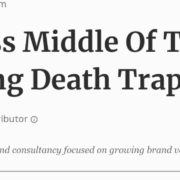Brands and Warnings Labels: Europe’s Nutri-Score and Lessons From The US
Beginning in 2017, Nutri-Score, the European food labeling system, went into effect. Nutri-Score is a color-coded, front-of-pack labeling system created to alert consumers to the nutritional content of food. Nutri-Score is a red light-green light approach that the EU hopes will help consumers make better food decisions.
According to FoodNavigator.com, Nutri-Score ranks food stuffs from -15 for the healthiest product to +50 for the least healthy. Using an algorithm, Nutri-Score assigns a “grade” with a corresponding color from dark green (A) to dark red (F).
The algorithm merges data on fat, sugar and salt content per 100g/ml of a given product, comparing against fruit and vegetable content, fiber and protein. So, for example, cheeses, European cultural icons, are 80% of the time “penalized” with a D or an F… the dark red doom designator. According to online NewsTex Blogs, the protected-origin producers of Italian cheeses Parmigiano Reggiano, Grana Padano and Asiago are furious. Parmigiano Reggiano is allowed to use only three ingredients – cow’s milk, sea salt, rennet – and not allowed any additives or preservatives. Yet, these national treasures will be graded as dangerous.
Spain’s meat industry is up in arms, believing that Nutri-Score focuses on “negative ingredients” sorting foods into “good foods” and “bad foods”. Italy believes that Nutri-Score is a cultural tsunami designed to wipe out its cuisine. The Mediterranean Diet is considered one of the healthiest in the world according to UNESCO, as well. However, Nutri-Score rates Italian food stuffs such as cheese, cured ham and olive oil as less healthy. Spain has decided not to use Nutri-Score on its olive oil.
The stated reason for Nutri-Score is Europe’s high level of obesity. One in two Europeans are considered overweight or obese. The European Consumer Organization believes this is a public health crisis exacerbated by COVID-19, since weight is considered one of the pandemic’s biggest risk factors. Reporting on Unilever, Financial Times pointed out that The World Health Organization (WHO) states obesity has tripled globally since 1975. And, although governments are looking to combat obesity, there are “contentious” issues as with confectionary and “treats”. Financial Times quotes a financial advisor who indicated obesity is now considered an ESG issue (environment, social, governance). But, he said, to think that labeling and other initiatives will stop Lindt from selling chocolates or Diageo from selling alcohol will just not fly in Board rooms. Shareholders will not shoot themselves in the foot by eliminating the dividends.
Nutri-Score aims to change consumers’ behaviors. The hope is that consumers will see the colors and the letter grades and make healthier food choices because of the foods’ nutritional composition. With this transparent “health” information on the front of the package, consumers will compare items not just on price but on being a better overall nutritional choice.
Although dished up as a nutritional classification system, Nutri-Score is essentially a warning label. After all, if your brand is marked with a dark red F, the implication is “eat this and you are one bite away from a coronary.” This dark red F is today’s scarlet letter.
As you can imagine, Nutri-Score has engendered a lot of push back. Six global brands – Nestlé, PepsiCo, Coca-Cola, Modelez, Unilever and Mars launched their own system, an initiative that quickly failed. The common agreement among the big global food companies is 1) that there are no bad foods only bad diets; 2) that all foods have nutrients; and 3) a balanced diet has room for a Snickers bar or a soft drink. Just remember to eat in moderation.
Even with all of the push back and national indignity, most of the large food firms have signed on to Nutri-Score. Several supermarkets, such as Carrefour and Lidl have also signed on.
The European powers that be and the signatories to the labeling are quite vocal that based on research Nutri-Score is the best “labeling scheme” currently available. This caveat should be kept in mind: Nutri-Score is not perfect, but it is the best we could do. Several different warning labels were tested; Nutri-Score was the winner… perhaps the best of the worst?
The CEO of Danone said “… no system is perfect, yet the company sees Nutri-Score as the best label currently available for people to compare products’ nutritional quality at a glance. We support the call to make it mandatory in the EU.”
The CEO of Euroconsumers, an umbrella organization designed to “promote and defend consumer interests” across a wide range of topics such as freedom of choice and right to health issues, agreed. He said research from several European countries “… shows that Nutri-Score is the easiest label to understand and the best-performing scheme in aiding consumers to compare the nutritional value of foods and range of products.” Again, based on the different options tested, Nutri-Score was the easiest to comprehend at a glance: green good/red bad.
In the US, we are familiar with warning labels.
It is difficult to find a product that does not have a warning label on its package. From baby wipes (the plastic package can cause suffocation, do not flush the wipes) to vehicles (keep the visor closed so the air bag can deploy, SUVs have a high risk rollover) to Whole Foods rice pilaf products (contains wheat ingredients, may contain milk, eggs, shellfish fish and soy).
When it comes to warning labels, California leads the way. if you want to have your pants scared off, go into any common laundry room in an apartment building. You will see warning signs that washers and dryers are dangerous to your health. This warning comes from California’s Prop 65. California’s Prop 65 states that appliances may contain harmful chemicals that can cause cancer and/or birth defects or other reproductive harm. Prop 65, introduced in 1987, has a list of over 800 potentially dangerous chemicals. For example, if you were thinking of a new couch from Wayfair just remember that California Prop 65 can put a warning label on your desired product. The warning will alert you that the sofa can expose you to levels of a listed chemical or chemicals that pose greater health risks than another piece of furniture with lower levels of listed chemicals. Do I want to binge TV on a bad-for-my-health couch?
California is an extreme example. However, the issue is, do warning labels work? People still buy and use washers and dryers. People still buy furniture. Do warning labels actually change behaviors? Are warning labels good or bad for brands?
Clearly, warning labels protect the manufacturer from liability issues and PR nightmares. Peloton had a crisis this past year when a child was killed by its Tread product. Peloton fought a warning label but eventually conceded. Did the warning label stop consumers from purchasing the product? Or was it the cost? Or was it the decision to return to the gym? Or the decision to return to the outdoors?
The warning labels on cigarettes and alcoholic beverages provide some important information on behavior change.
In 1969, the US passed the Public Health Cigarette Smoking Act. This act prohibited cigarette advertising on TV and radio. It also required each cigarette pack, carton and print ad to carry a warning label: SURGEON GENERAL’S WARNING: The Surgeon General Has Determined That Cigarette Smoking is Dangerous to Your Health. The warning label was – and still is – a white rectangular box with black letters. A recent print advertisement for Lucky Strike brand, used this version of the warning: SURGEON GENERAL’S WARNING: Smoking by Pregnant Women May Result in Fetal Injury, Premature birth, And Low Birth Weight.
Kodiak Moist Snuff (chewing tobacco) runs a black box (twice the size of the cigarette warning box) with white letters stating, WARNING: This product can cause mouth cancer.
Do these warning labels work? Here is what we know. First, seeing a warning label is not the same as reading a warning label. Reading a warning label is not the same as heeding the warning label. Second, people who saw the white box knew it was the warning label. They did not need to read it; they knew it was a warning. Why bother, I know what it will tell me. Third, graphic labels of cancerous mouths, etc., such as some countries use, had negative impact on the image of cigarettes and cigarette brands but did little to affect cessation of smoking.
When the Public Health Cigarette Smoking Act was passed in 1969 cigarettes cost 25 cents a pack. Today, a pack of cigarettes costs, on average, $6.98, or about 35 cents a cigarette. In the state of Florida, smokers pay around $63 dollars for a carton of cigarettes. In 1970, the highest price for a cartoon of cigarettes might have been $3.50. Many believe that cigarette smokers’ behaviors changed due to the rapid increase in prices rather than the warning labels. There are still, 53 years later, multiple PSA TV ads advising us not to smoke. Even at almost $7 a pack, people are still smoking.
In 1988, The Alcoholic Beverage Labeling Act was passed. After November 1989, all alcoholic beverages had to alert consumers to the multiple health issues associated with alcohol including reproductive issues and fetal harm. The current alcohol warning states: GOVERNMENT WARNING: 1) ACCORDING TO THE SURGEON GENERAL WOMEN SHOULD NOT DRINK ALCOHOLIC BEVERAGES DURING PREGNANCY BECAUSE OF THE RISK OF BIRTH DEFECTS. 2) CONSUMPTION OF ALCOHOLIC BEVERAGES IMPAIRS YOUR ABILITY TO DRIVE A CAR OR OPERATE MACHINERY, AND MAY CAUSE HEALTH PROBLEMS. (Yes, the alcohol warning label is in capital letters.)
In one alcohol study, data showed that 64.3% of purchasers saw the warning label; 38.8% of purchasers read the warning label; 25.5% of purchasers said they heeded the warning.
In the US, after decades of food labeling, the results of behavior change are still unclear. A recent study by The American Journal of Preventive Medicine showed labeling “… reduced the intake of calories by 6.6 percent, total fat by 10.6 percent, and other generally unhealthy choices by 13 percent. They also increased vegetable intake by 13.5 percent.” However, these data are not reflective of other data showing that after all the decades of food pyramids and nutritional labeling, there is little agreement and little evidence that food labels affect consumers’ intakes of total carbohydrates, protein, saturated fat or sodium. Nor did labels affect consumption of fruits, whole grains, or other healthy options.
Nutri-Score may be experiencing the same lack of clarity as to effectiveness.
A recent November 2021 Belgian journal article’s data sets showed that Nutri-Score consumer purchases were mixed. There were some positive effects. However, the study concluded that “shelf labeling on its own is unlikely to significantly influence consumer behaviors.”
Other European data indicate that the degree of influence Nutri-Score has on consumer decisions is unclear. An August 2021 study showed consumers were still not clear about the color-coded Nutri-Score. A 2019 Nielsen study showed that only 14% of French consumers “noted the guidance of the Nutri-Score label.” Not surprising when you consider that beloved Brie or Camembert cheeses as well as butter are on the wrong side of the system’s health spectrum. This goes against centuries of French gastronomy.
One of the issues plaguing the Nutri-Score system is credibility. Since its algorithm factors in sugar content, Nutri-Score rated orange juice as unhealthy but rated Coca-Cola Zero healthy. In a Nestlé-generated survey, sixty-percent of consumers thought the Nestlé cereal brands would score well below a C on Nutri-Score. But, Nestlé publicly touted Nutri-Score ratings that its sugared cereals actually earn a C or above on the Nutri-Score spectrum. This is because the system has a positive bias for fiber.
Hopefully, the Nutri-Score system will evolve its algorithm to better reflect the fact that there is a benefit to the idea of balanced diets and moderation. Nutri-Score should fix the blanket rejection of products such as meat. Putting ecological concerns aside, meat does contain iron, vitamin B12, protein and minerals. Nutri-Score does not currently assess the impact of trans fatty acids, something else that meat does not contain. And, Nutri-Score should take into account that not all obesity can be affected by diet. Further, the risk to national cuisines is real and needs to be calibrated. The algorithm also must include portion sizes, a real problem in the US.
Also, algorithms do not recognize the fact we first eat with our eyes. Foods have hedonic feelings associated with taste and emotions that no algorithm can take into account … as of yet. People eat for both physical and physiological reasons. There are differences between eating when one is hungry versus eating for indulgence. Taking delight out of diets is dreary.
Warning labels are all around us, stuck on brands across all categories. We have learned over time that the effect of such labels do some good but less than expected. In many cases, the warnings are ignored, or accepted, or accepted and then ignored. Certainly, it is important to point out that some items are dangerous. For example, the plastic bag draped over your dry cleaning can cause suffocation.
Behavior change is tough. In fact, in most instances, facts, data, experts, or science make people dig in their heels. Social science research on behavior change indicates that asserting science, facts or data to change minds generates a “backfire effect”. When confronted with information that is contrary to set beliefs, some people become even more set in their ways.
This is not to say that behaviors can never be changed. Wanting consumers to change their behavior is not a losing battle: it just requires a different strategic approach. The best way to change behavior is to provide an alternative, desirable solution to their concerns. This is something that Nutri-Score does not provide.
If history is a factor than the Nutri-Score warning label will have an unclear, if limited, effect on behavior change.










